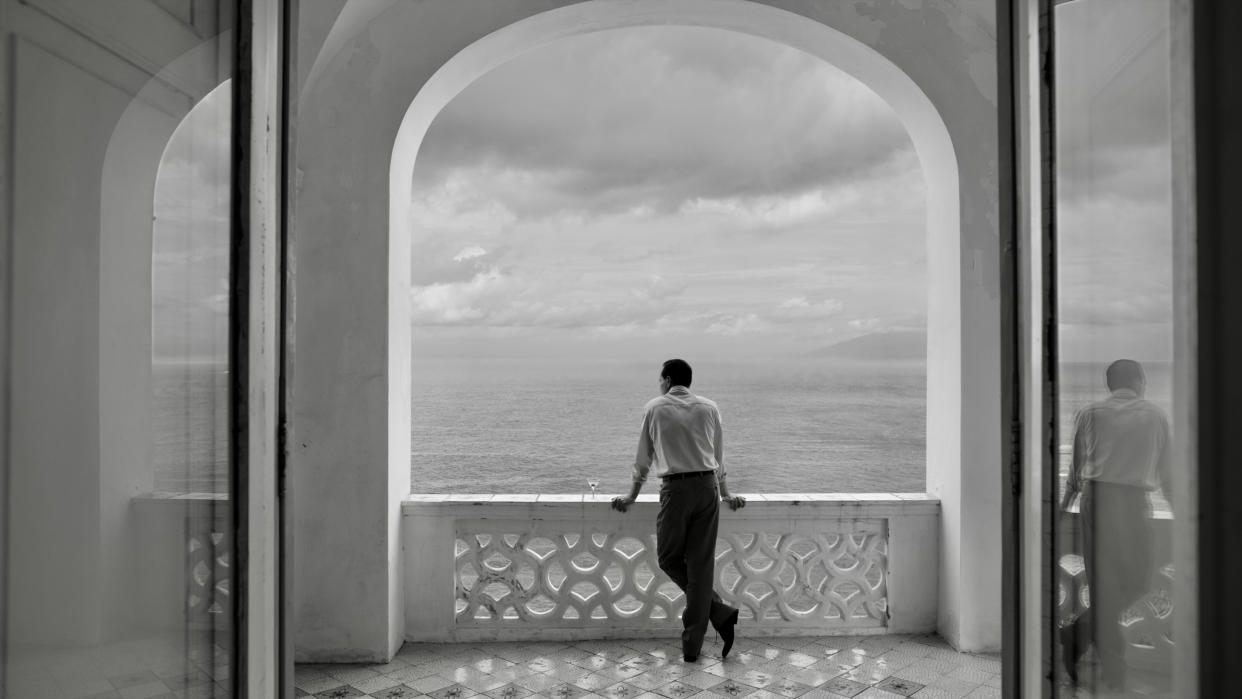That ‘Ripley’ Venetian Palazzo Is the Real Deal

- Oops!Something went wrong.Please try again later.
In Patricia Highsmith’s novel “The Talented Mr. Ripley,” Dickie Greenleaf’s father asks Tom if he’s ever read Henry James’ novel “The Ambassadors.” The reference is a sly one; James’ 1903 book is about a man sent from the Northeast to Paris to bring back a wayward son. That’s Tom’s mission, as well, though his European transformation is starkly different from James’ Lewis Lambert Strether, who ultimately returns to America wiser but sadder.
Tom intends no such return, and who could blame him when he sets up house in a palazzo as magnificent as the one in Steven Zaillian’s Netflix adaptation “Ripley.” “Who died?” his frenemy Marge (Dakota Fanning) quips when she first sees it; the answer is, of course, Dickie Greenleaf, but Tom pretends it was the aunt who raised him.
More from IndieWire
“In 2005, I did the film ‘Casanova,’ directed by Lasse Hallström,” “Ripley” production designer David Gropman told IndieWire. “So I pretty much knew every palazzo in Venice [and] I knew exactly where to go.” Ultimately, the 15th-century Palazzo Polignac became the site of Tom’s Venetian life. “We looked at a lot of stuff; Steve has such a great eye, and he cares so much about detail and preserving his vision, his point of view.”
The palazzo is stunning, of course, but it carries with it both a sense of age and also a sense of darkness. Tom is a far cry from the beachside villa where he first met Dickie and Marge (filmed in Capri), as befits the new Ripley with more life experience and two murders under his belt. And much of the furnishings were authentic to the palazzo.
“What we really didn’t touch was his bedroom. That great sort of canopy bed and those drapings were there,” Gropman said. “We changed the bedspread. But we completely furnished his study where the whole scene with Ravini takes place. So that was completely dressed by us. The fabric on the walls belonged to the Palazzo. But that’s the great thing about that Palazzo. It’s got You know, they’re not, in that Palazzo, they’re not afraid to let the age show, the fading of the wall coverings and the tears and all of that.”
The “Ripley” production utilized quite a few Venetian palazzos for some surprising scenes. Tom’s trip to Brooks Brothers before setting out for Italy was filmed in the Palazzo dell’Aeronautica, as was the scene in the Naples American Express. (The exterior of the latter is the Naples Palazzo della Poste.)
Gropman also relied on books of photographs from the era (and slightly before) to guide the look of “Ripley,” citing “Neo Realismo: The New Image in Italy 1932-1960” as his starting point in designing the black and white world Zailian envisioned with cinematographer Robert Elswit. “I kind of knew exactly in my mind what it should look like,” Gropman said. “It’s freeing in some respects doing a period film [in black and white] because it’s easier to cheat on some things. But the challenge I found is, when you erase color, to be able to show the arc of the story and differentiate the moments in Tom’s journey. And for the film to be monotone but not the expression.”
But of course, any production shot in black and white brings with it singular challenges, especially when it comes to existing locations. “The best exercise for me is that, as I’m putting together sets, I photograph them nowadays on my iPhone in color,” Gropman said. “And then when I would go back to look at the location photos and put them into black and white, you immediately begin to see how you have to manage things, how you have to think about contrast and make sure that details don’t get glossed over or muddled or left behind.”
The combination of Gropman’s production design and Elswit’s sensuous black-and-white cinematography proves to be an alluringly lethal one — both for Ripley and for “Ripley.”
All eight episodes of “Ripley” are now streaming on Netflix.
Best of IndieWire
The 12 Best Thrillers Streaming on Netflix in April, from 'Fair Play' to 'Emily the Criminal'
Quentin Tarantino's Favorite Movies: 61 Films the Director Wants You to See
Sign up for Indiewire's Newsletter. For the latest news, follow us on Facebook, Twitter, and Instagram.

